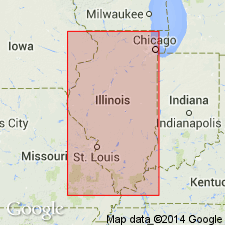
- Usage in publication:
-
- Beverly Tongue*
- Modifications:
-
- Original reference
- Dominant lithology:
-
- Sand
- Gravel
- AAPG geologic province:
-
- Michigan basin
- Wisconsin arch
Summary:
Pg. 17 (fig. 9), 18, 35 (fig. 19), 43, 59-60, 103. Beverly Tongue of Henry Formation of Mason Group. Stratified coarsening-upward sequence of sand and gravel [previously included in overlying Haeger Member (restricted) of Lemont Formation of Wedron Group]. Thickness up to 98 feet (30 m). Is a fairly continuous subsurface unit that is an important aggregate resource and aquifer in parts of McHenry, Lake, Kane, and Cook Counties, northeastern Illinois. Commonly overlies Yorkville Member of Lemont Formation and interfingers with Equality Formation of Mason Group. Correlates with basal part of New Berlin Member of Holy Hill Formation of Wisconsin. Interpreted to be of proglacial fluvial origin. [Age is Pleistocene (Wisconsinan Age; Woodfordian Subage), based on age of Henry Formation.]
Type section: Beverly sand and gravel pit, a large pit about 2 mi (3.3 km) east of IL Highway 25 and I-90 intersection northeast of Elgin, in Kane and Cook Cos., northeastern IL. Named from Beverly sand and gravel pit.
Source: Publication.
For more information, please contact Nancy Stamm, Geologic Names Committee Secretary.
Asterisk (*) indicates published by U.S. Geological Survey authors.
"No current usage" (†) implies that a name has been abandoned or has fallen into disuse. Former usage and, if known, replacement name given in parentheses ( ).
Slash (/) indicates name conflicts with nomenclatural guidelines (CSN, 1933; ACSN, 1961, 1970; NACSN, 1983, 2005, 2021). May be explained within brackets ([ ]).

